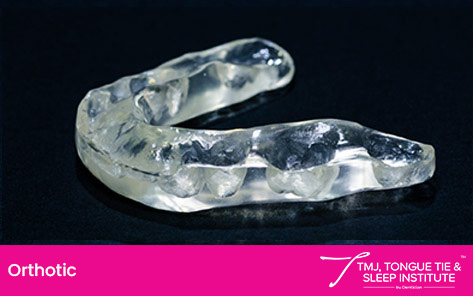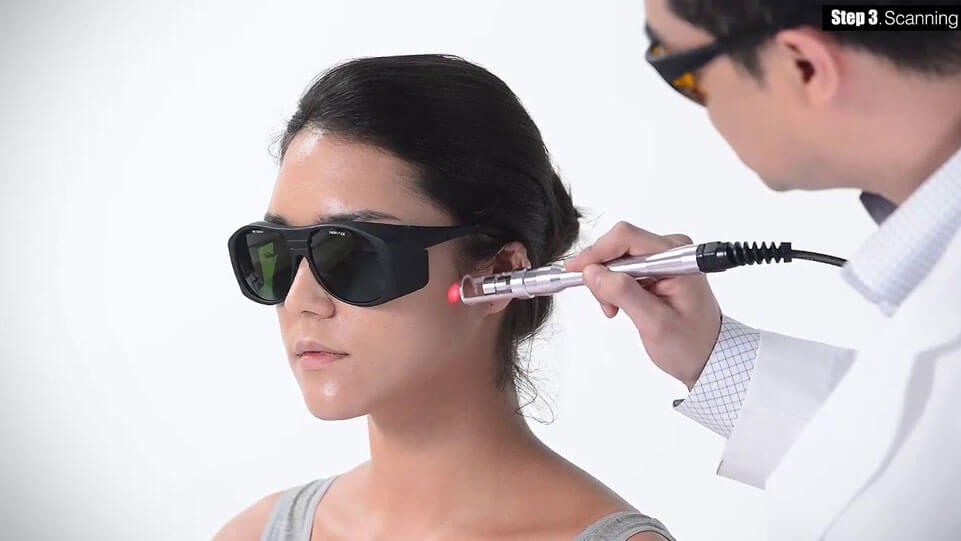SIMPLE JAW EXERCISES FOR TEMPORARY PAIN RELIEF FROM TMJ Written By: Dr. Ankita Shah, 15 October 2023

TMJ – short for Temporomandibular joints – are placed immediately in front of the ears, on both sides of the face. It connects the lower jawbone to the cranium and facilitates eating, speaking and various jaw movements.
Temporomandibular disorders or TMD refer to conditions affecting the jaw and the facial muscles around the jaws, the neck and shoulders. It may result from an incorrect bite, trauma, arthritis, stress, or incorrect posture.
TMJ frequently causes excruciating pain and agony, which can be transient or long-lasting, affecting either side of the face. Headaches and migraines, ear ringing and itchiness, pressure behind the eyes, tooth sensitivity and facial pain are some of the primary symptoms of TMD.
Get relief from TMJ pain with simple and effective jaw exercises. Discover how to alleviate your symptoms and start feeling better.
A] TMJ Pain Relief Exercises
Jaw relaxation exercise: Jaw relaxation exercise is simple to include in your daily routine and can be done anytime and anywhere. In this simple jaw exercise, all one needs to do is lift and touch their tongue to the roof of the mouth. Make sure that the tongue stays behind the upper teeth. While doing so, open your mouth and separate your teeth for relaxing the TMJ.
Partial jaw opening exercise: In this exercise, you need to put one finger on your TMJ (located near the ear) and the other in the middle of your chin. Next, open your mouth halfway and close it back. For this exercise, make sure to do at least one set every day. Each set includes 6 reps.
Full jaw opening exercise: This is another variation of the above jaw exercise. In this, put the tongue on the roof of the mouth behind your upper teeth. Using the same finger placement as before, open your entire mouth and close it back. Repeat this six times for one set.
Massaging: Applying gentle pressure over the temporomandibular joint (TMJ) region can help relax the tense muscles that develop due to TMJ disorder. Do at least 15 reps of this pressure-treating exercise daily. Ideally, the 15 reps should be done in one go.
Chin tucks: For this exercise, pull your shoulders back and open your chest. Next, move your chin-up straight and tuck it back in, creating a double chin. Repeat this exercise about ten times per day.
Resist mouth-opening: In the resist mouth-opening exercise, you need to hold your chin with the thumb under it and your index finger above the chin. Next, open your mouth gently, push it against the chin and hold it for 10 seconds. It’s like a tug of war. You should feel slight resistance but no pain. Perform this exercise 10 times/daily.
Resisted mouth-closing: Put both the thumbs under the chin and cup the chin with the index finger in the depression below the lower lip. Open and try to close your mouth while putting gentle pressure on the chin. You should resist the pressure while making an attempt to close your mouth. Repeat this ten times to exercise and strengthen your muscles.
Tongue up: Another simple jaw exercise, here, you need to rest your tongue to the roof of the mouth and open and close your mouth 20 times to complete one set. Do this twice a day.
Jaw movement (side-to-side): Take small objects like ice cream sticks or tongue depressors and stack a few together to get a 1/4th inch height. Put them in between your teeth and keep them stationary as you move your jaw from side to side. When it starts getting easy, increase the size of the stack.
Jaw movement (forward): Similar to the previous exercise, place a 1/4th inch object between your front teeth. Next, move your lower jaw in front and back repeatedly in a way that brings the bottom teeth ahead of the top. Increase object thickness as the exercise becomes more seamless.
B] Treatments For TMJ Pain Relief
In addition to the above-mentioned jaw exercises for TMJ, specific treatments can also help relieve TMJ pain. Some of these include:
Orofacial Myofunctional Therapy (OMT): Orofacial myofunctional treatment prioritises fixing the root cause of TMD. OMT constitutes a neuromuscular re-education of the motor function to enhance the capabilities of swallowing, oral respiration, and resting position of lips, tongue, and cheeks. It also helps increase postural stability, tone, and movement. Orthodontic treatment is supplemented by OMT, which aims to synchronise orofacial activity. It comprises oral muscle strengthening and resistance exercise activities.
GNeuromuscular Orthotics: GNeuromuscular orthotics is a splint kind of device. It is a custom-made, transparent splint that helps relax the posture of the jaw and muscles by realigning the jaw and the nerves surrounding it. The jaw will start to gradually feel natural and you would see enhancement in your body posture. Eventually, as the muscles start to align, your neck, shoulder, back and entire body will become stronger.

Functional Neuro Myofascial Massage Therapy (FNFT): As a muscle massage therapy, FNFT is used to treat skeletal muscle stiffness and pain. It helps promote the circulation of blood & oxygen and lymphatic movement. This therapy also helps relax the trigger points in the muscles and tissues. FNFT can be administered simultaneously intra-orally and extra-orally to rapidly alleviate symptoms of TMJ and facilitate faster recovery.
Low-Level Laser Therapy (LLLT): To increase jaw function & mobility and lessen discomfort, TMD patients can also opt for LLLT, which is a non-invasive treatment. As a quick therapy, it helps save time and the patient can see immediate improvement from the treatment. LLLT is offered as a supplementary treatment to FNFT. It is believed that this therapy can help heal the damaged connective tissues faster and reduce inflammation.

C] General Remedies For Temporary TMJ Relief
Apart from the above exercises for TMJ disorder and treatment options, there are also some temporary TMJ relief remedies that you can try. However, for a permanent TMJ cure, you should consult with a TMJ specialist.
1. Improve posture
While neck misalignment can lead to TMJ problems, the opposite of this is also true i.e. TMD can also lead to neck pain. Clicking and popping of the joints, deviation of the jaw, jaw locking, cramping or spasming of the jaw or neck muscles are all possible results of TMD and posture.
Improper posture has a direct relation to jaw pain, so paying attention to the spinal alignment when sitting or standing can help alleviate jaw pain and improve posture. TMJ discomfort might be alleviated with consistent efforts to improve your posture alongside using GNM orthotics.
To improve posture, you need to take frequent breaks from sitting at your desk. Finding a seat with proper back support can also help. In addition, always maintain the correct standing and sitting posture.
2. Get a good sleep at night
Getting enough sleep is essential for those with TMJ. However, orofacial pain and TMJ symptoms can be worsened by any activity that puts unnecessary stress on the face, head, jaw, neck, or shoulders. Thus, even when sleeping, to relax the TMJ pain, certain precautions must be taken.
Firstly, it is important not to sleep on your side or stomach. Sleep on your back to ensure that your jaw muscles do not get pressed.
Secondly, it is essential to provide ample support to your jaw. Place pillows around your neck to provide cushioning. Also, choose a sleeping posture that doesn’t cause teeth clenching or grinding. Snoring, sleep apnea or mouth breathing can lead to teeth clenching, ultimately resulting in TMJ pain.
3. Use a hot and cold compress
Temperature treatment using hot and/or cold compress can help relieve TMJ pain. Cold compresses are used in times of acute pain and inflammation followed by moist heat compresses to improve the blood circulation to the muscles. The compress can help relax and unclench the muscles in the affected area. Here, to relieve pain, apply hot and/or cold compress daily for about 15 to 20 minutes.
4. Reduce stress
Stress can manifest itself in physical forms, and TMJ can be one of them. Alternatively, TMJ can lead to stress and anxiety. Thus, to reduce stress, try meditation or yoga. Also, make conscious efforts to relax the jaw muscles to relieve pain.
5. Maintaining good gut health
Did you know that your digestive health can be affected by TMJ? TMJ makes chewing food difficult, which, in turn, can affect your gut health. It has been noted that TMJ patients have more digestive problems as unchewed food is difficult to digest. Also, since the food is not digested-well, your body is unable to absorb vital nutrients, which affects your overall general health.
Maintaining gut health is crucial to alleviating TMJ pain. Also, when your gut is not healthy, you may experience symptoms like increased acid reflux, leading to chest pain that may radiate to your jaw, neck and throat.
6. Nutritional supplements
Nutritional supplements play an essential role in improving TMJ disorder. Supplements like B12, magnesium, calcium and vitamin D3 provide necessary nutrients to the body for faster recovery. These nutrients also help relieve stress, boost sleep and provide energy.
Magnesium: Magnesium deficiency causes spastic muscles and can affect your bone, nerve, and cartilage health. Together with calcium, magnesium can relax jaw muscles and reduce TMJ pain. It can help improve sleep quality. It can also help soothe your nervous system, thereby reducing anxiety which disrupts sleep.
Calcium: 99% of the body’s calcium is in the bones. Thus, it makes sense that bones, even TMJ bones, need calcium to keep them healthy. Calcium affects muscular contraction, nerve impulses and hormone modulation, so a lack of calcium can lead to TMJ discomfort.
Vitamin D3: Most people receive vitamin D3 through sunlight and green foods. Sufficient vitamin D3 can help reduce pain, improve sleep and strengthen bones. Calcium with vitamin D3 can also help alleviate TMJ pain.
Vitamin B12: Lack of vitamin B12 can lead to trigeminal neuralgia – a sudden, severe facial pain. It can also lead to tingling in the hands or feet and cause fatigue. Thus, increasing your vitamin B12 intake is important for TMJ pain relief. Also, B-complex vitamins help reduce stress, which is a key TMJ contributor.s
7. Foods to avoid for TMD/TMJ
Chewy or sticky foods that require prolong chewing must be avoided if you are experiencing TMJ pain. Similarly, avoid hard and crunchy foods like raw carrots and veggies, ice, toffees, pretzels, etc. For TMJ, eating soft foods is advised, such as mashed potatoes, eggs, cooked veggies, sweet potatoes, etc. This will help alleviate jaw pain.
Get relief from TMJ pain with simple and effective jaw exercises. Discover how to alleviate your symptoms and start feeling better.
Conclusion
To prevent TMJ from getting severe, it is important to note the symptoms and get appropriate treatments. Early TMJ treatment ensures less risk, quicker recovery, and less damage to the muscles & bones. Also, by practising simple jaw exercises, it is possible to combat or alleviate some of the TMJ pain.
However, if TMJ is allowed to go unchecked, it can hinder daily tasks like eating, speaking and even sleeping. Thus, take action today and get in touch with an OC-trained dentist who uses Gneuromuscular dentistry (GNM) and orthopedic treatments to effectively treat TMJ.
